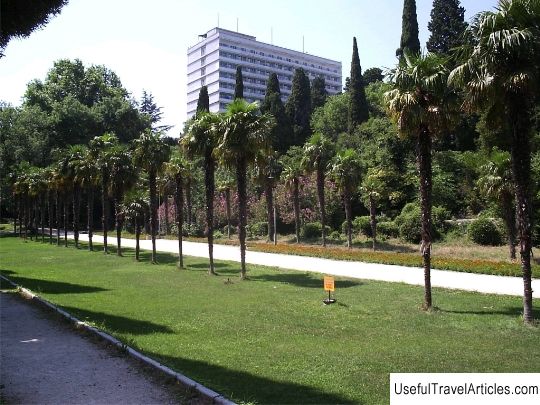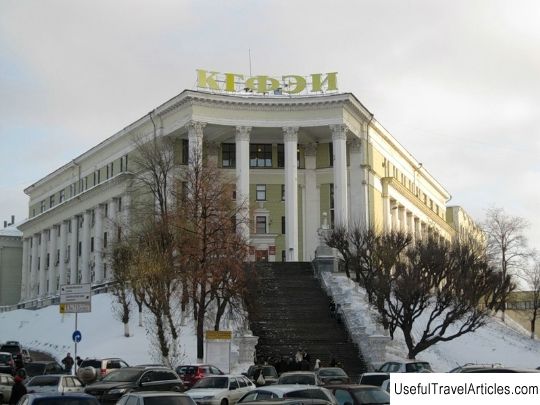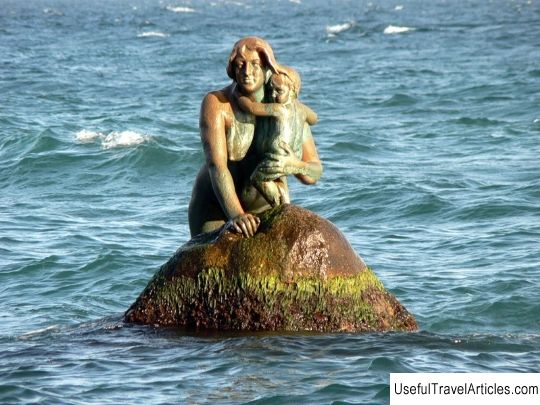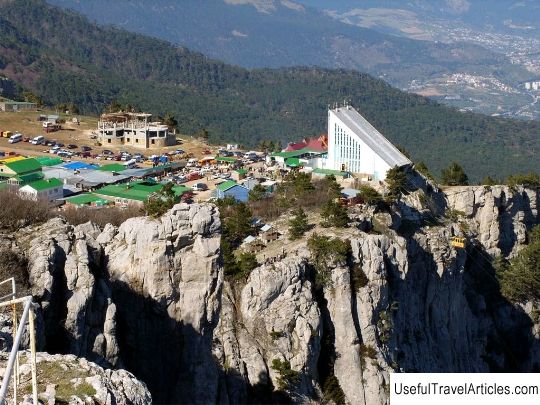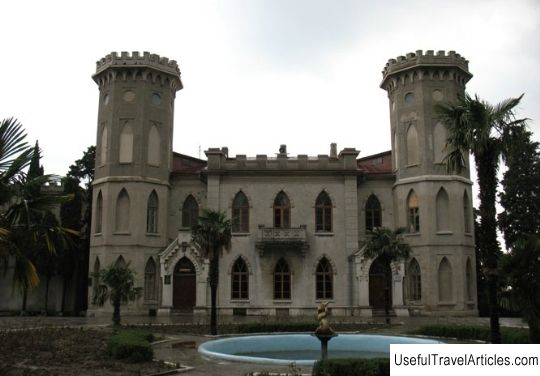Yusupov Palace description and photos - Crimea: Koreiz - Miskhor
Rating: 7,8/10 (5022 votes) 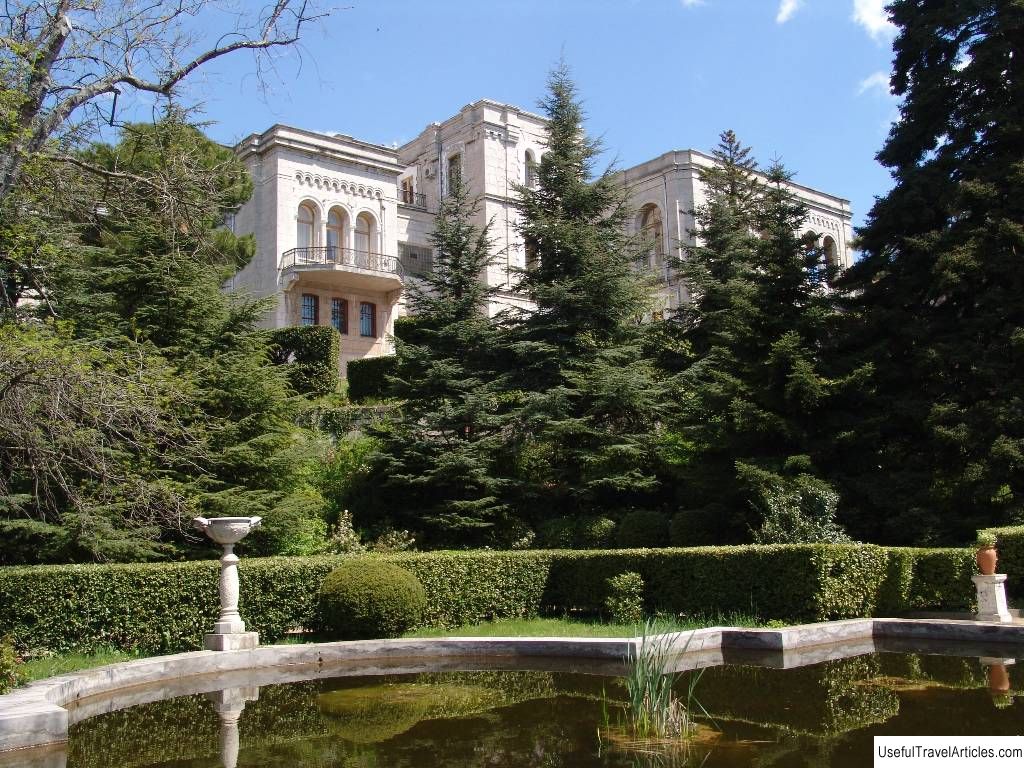
Yusupov Palace description and photos - Crimea: Koreiz - Miskhor. Detailed information about the attraction. Description, photos and a map showing the nearest significant objects. Photo and descriptionIn Crimea, on its southern coast, where the mountain spurs Ai-Petri drop off abruptly to the sea, in the ancient town of Koreiz, there is the Yusupov Palace - a manor palace -park complex-reserve. A small village Koreiz owned in the first half. XIX century Anna Sergeevna Golitsyna . An eccentric lady educated and brought up in the enlightened 18th century, she acquired this estate in order to found a "colony of hardworking pietists" in 1824. By the time she was over forty, she was rich, about her quirks, passion for mysticism and unhappy family life knew the whole Petersburg. She broke up with her husband, Ivan Alexandrovich Golitsyn , just a few months after the wedding. This was not an official divorce - it was not easy to get a divorce in those days, the couple simply lived separately. He squandered and gambled the remnants of his fortune, while she read German mystics and preached to St. Petersburg society. At one time it was fashionable: Alexander I and himself was fond of mysticism. A. Golitsyna was friends with the famous mystical writer Baroness Yu. Krudener and her daughter, and when the mystics and preachers of pietism fell out of favor with the emperor, they all went to Crimea. The Pink House A plot of land was bought in a picturesque place, in 1825 construction of a house began, and a little later the Gothic Church of the Ascension was built on an old foundation ... Golitsyna still behaved as she pleased, dressed in a man's dress, called herself "the old woman of the mountains." The estate, however, she built a beautiful and cozy, they called it "The Pink House". The park around it was created by Karl Kebach , the main Crimean gardeners of that time. He planted so many roses that they gave the name to the place. From the orchards of those times, only one tree has now survived - a century-old quince, which still bears fruit every year. Despite her deep religiosity, Princess Golitsyna began to winemaking . Its wine cellars have survived to this day. Now the so-called " Golitsyn Palace " stands above the basements - these are not the remains of a summer residence, but a house in which there was once a wine production. Here Golitsyna died and was buried in the Church of the Ascension . Koreiz by will went to Baroness Yu. Berkheim , daughter of J. Krudener, then again passed to the relatives of the old princess. Part of it was sold to Goncharov, and part to the famous millionaire Timofey Morozov (and he made himself a "Morozovskaya Dacha" here). And since 1867, all the neighborhoods have become the possession of the Yusupovs. The Yusupovs Palace Prince Felix Feliksovich Yusupov Sr. entrusts the construction of the palace to the famous architect N. Krasnov - the one who built the royal palace in Livadia. The Rose Dacha was almost completely rebuilt. Work began in 1909, and continued until 1915, although the neo-romantic palace was already ready by this time. The park was landscaped and utility rooms were built. The Yusupov Palace stands on the slope of a mountain. The architect applied the method of asymmetry : on the side of the building that faces the mountains, one number of floors, and on the one that faces the sea, another. Used "Moorish" arches over the windows. Even the outbuilding, which housed the laundry, was built in the same style. The architect paid attention not only to how the palace itself would look from the outside, but also what views would open from it to the surroundings. Such points for the windows were specially chosen so that from them admire the most beautiful panoramas. The interior decoration was made in the Art Nouveau style , from her, Unfortunately, only a few elements have survived. Yusupov Sr. got carried away with collecting sculptures and set up numerous statues in the park. There were marble and bronze lions, naiads, nymphs. A mermaid statue was installed on the beach, which was regularly demolished into the sea, but the owner persistently ordered the installation of the next one. Another statue - Athena-Minevra , standing on the shore with a torch, vividly resembled the Statue of Liberty in New York. This was also the latest trend in fashion at the beginning of the 20th century: "Freedom" was installed quite recently, in 1886, and there was a lot of talk about it. Most of the park sculptures have survived: for example, sculptures of lions at the entrance, commissioned in Venice. busts of maenads and satyrs have survived. Eyewitnesses claimed that they have a portrait resemblance to the owners of the estate: Yusupov Sr. and his wife Zinaida Nikolaevna. On the shore there was an unprecedentedly expensive structure for those times - a heated pool . One could swim in it all year round. Felix Feliksovich Yusupov Jr. , who came here every summer in childhood and adolescence, left memories. He writes in them not only about the most important episode of his life - participation in the murder of Rasputin , but also about his childhood spent in Koreiz. The family rested here almost every summer. Here, following the royal family, who were vacationing in Livadia, the entire capital's aristocracy reached out. And not only Russian. Yusupov recalls that two Montenegrin princesses lived nearby, who were engaged in black magic here. As an entertainment, the estate was invented "day of the ram" - a picnic for the nobility, in the open air, surrounded by sheep and goats decorated with colored ribbons. There were always many guests. In Crimea, they lived at home and came to visit each other with whole families. The most frequent visitor was the elderly Field Marshal Dmitry Sergeevich Milyutin , who lived nearby in Simeiz. The main Crimean winemaker Lev Sergeevich Golitsyn came from Novy Svet. The local manager was a rare eccentric. For example, once before the arrival of the owners, he painted the gray walls of the palace like bricks, and all the statues in flesh pink. Old man Yusupov did not like it. The manager has been calculated. Yusupov Jr. himself did not like the house here too much - he found it ugly and uninteresting. However, he loved to walk around the neighborhood. Once, while riding on horseback, he met his love here - Princess Irina Alexandrovna Romanova . But he preferred to celebrate the wedding in his house in St. Petersburg on the Moika. The Yusupovs returned to Crimea for a short time, after the revolution. In 1917, these places were safer than the capital, and everyone who could from Petersburg literally fled to the south. Having reached the Crimea and having settled his family here, Yusupov returned to Petersburg for a while. He took from his house on the Moika with some family jewels and two paintings by Rembrandt, cut canvases straight from the frames. Then in emigration, the money received for them was enough for many years. By 1919, the revolution finally reached the Crimea. Most of the members of the royal family who ended up in the Crimea were arrested, and from day to day they expected the arrest of Irina Alexandrovna, nee Romanova. For the Yusupovs, who are related to the emperor, his death was not only a political tragedy, but also a personal one. Yusupov Sr. and Zinaida Nikolaevna left Russia in 1918 on one of the Allied ships, and in the spring of 1919 the English The battleship "Marlboro" also took the younger Yusupovs into exile, together with the Dowager Empress Maria Feodorovna, the grandmother of Irina Alexandrovna. None of them ever returned to Russia. Soviet times When the palace was nationalized, in it, as in many Crimean palaces, a sanatorium was opened. At first, mental workers rested here, and then the place became a departmental sanatorium of the VChKA. For two summers in a row (in 1925-26) F. Dzerzhinsky . He was very fond of Crimea, regularly came here to correct his already weak health by the twenties, and rested in Gurzuf for several years. And his last two summers - here (and he told in letters how he incautiously walking in the sun, burned his nose). During the Yalta Conference Stalin lived here. The palace was redecorated, all communications were renewed. We made a telephone connection with Moscow and connected our power plant. Now the "Stalinist apartments" are one of the most attractive premises for tourists. Many people want to take a look at how Stalin lived here. Wine cellars, left over from Golitsyna, were converted into a bomb shelter with two entrances and three rooms. It is now also a museum object with a sign " Stalin's bunker ". After the war, the complex became " State dacha number 4 ". So it was used as a state dacha for officials. At the beginning of the two thousandth a hotel was opened here. The Church of the Ascension, built by Golitsyna, did not survive the Great Patriotic War. Now at this place, believers are building a new temple - also Voznesensky. But in terms of architecture, unfortunately, it will not repeat the old church built in the Gothic style. Twenty-first century Now officially the park and buildings belong to the Presidential Property Management Department in Crimea . They are used as a state dacha and also as an expensive hotel. There are three large rooms in the palace itself: "Stalin", "Yusupov" and "Molotov". The hotel is used as the "Golitsyn Palace", a two-storey Gothic building above the former cellars. Little has survived from the interior of the palace of the Yusupov era. The premises have been used for living for many years, so inside there is quite modern furniture and decoration. Only the rooms in which Stalin lived have not changed - they were specially preserved as memorials. You can get inside only with a guided tour, but during periods when no events are held, you can buy tickets to the park. Interesting facts : - In front of the palace there are three palm trees planted here in honor of the Yalta conference. - On the beach, as in the time of the Yusupovs, there is a sculpture of a mermaid, which has to be replaced with a new one almost every year: during the winter storms, mermaids "float" into the sea. - The palace is hidden in greenery and the only part that is visible from the beach is the laundry.       We also recommend reading Duden Selalesi waterfalls description and photos - Turkey: Antalya Topic: Yusupov Palace description and photos - Crimea: Koreiz - Miskhor. |
